Factors Influencing Employee Motivation and Retention at Hilton
VerifiedAdded on 2019/12/18
|25
|7129
|150
Report
AI Summary
This report is a dissertation abstract and subsequent chapters that explores the crucial role of employee motivation and retention within the hospitality sector, specifically focusing on Hilton Hotels in the UK. It investigates the significance of reward mechanisms in enhancing employee satisfaction, motivation, and long-term retention. The study examines various factors influencing employee motivation, including intrinsic and extrinsic rewards, and analyzes their impact on job performance. The literature review covers theoretical models and conceptual frameworks related to motivation, while the methodology outlines the research approach, data collection methods, and analysis techniques. The findings highlight the importance of reward strategies in retaining employees and improving their focus on customer satisfaction. The report also provides recommendations for implementing effective reward systems to boost employee performance and satisfaction. This student assignment provides a comprehensive analysis of employee motivation and retention within the hospitality sector, with a focus on the practical application of reward mechanisms.
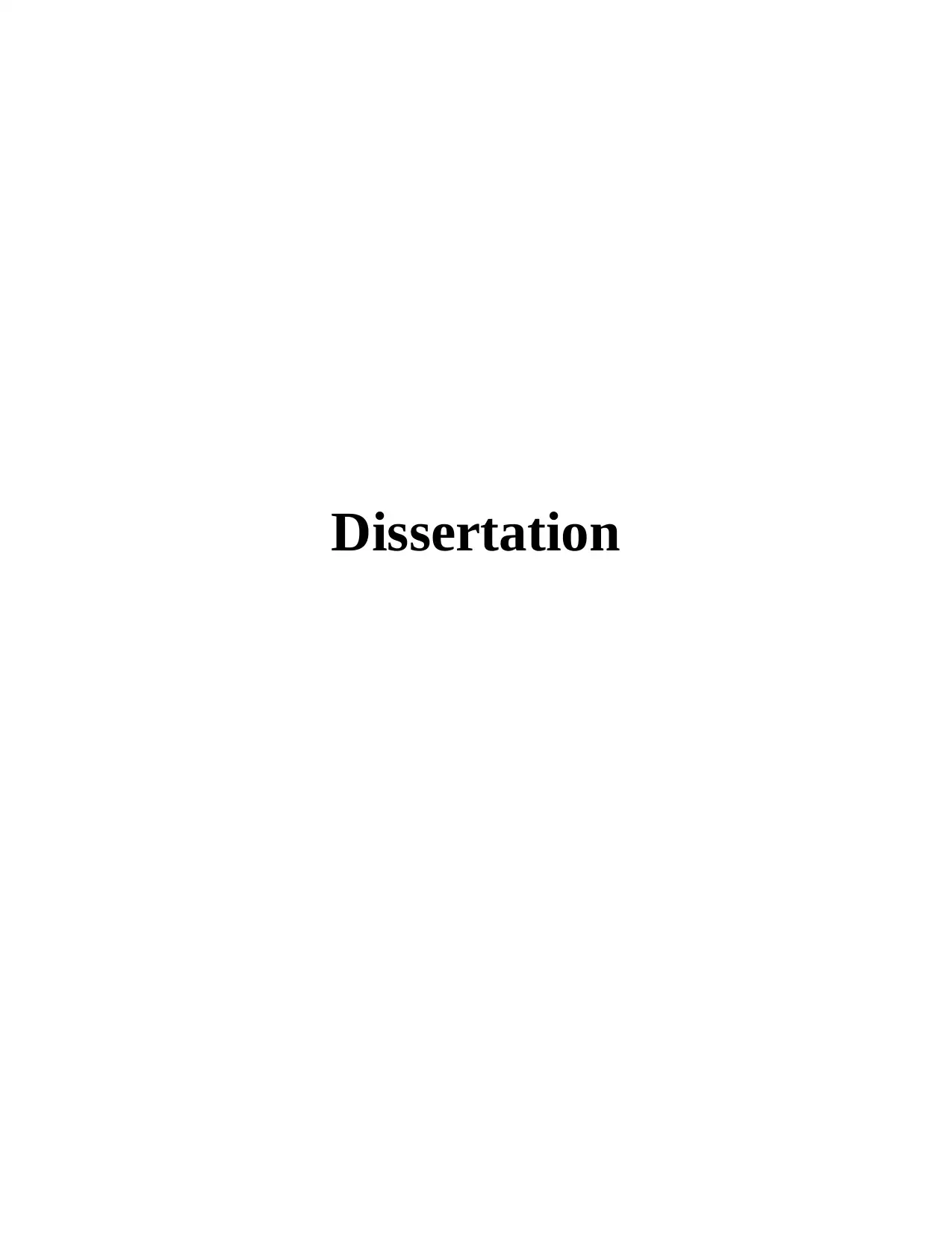
Dissertation
Paraphrase This Document
Need a fresh take? Get an instant paraphrase of this document with our AI Paraphraser
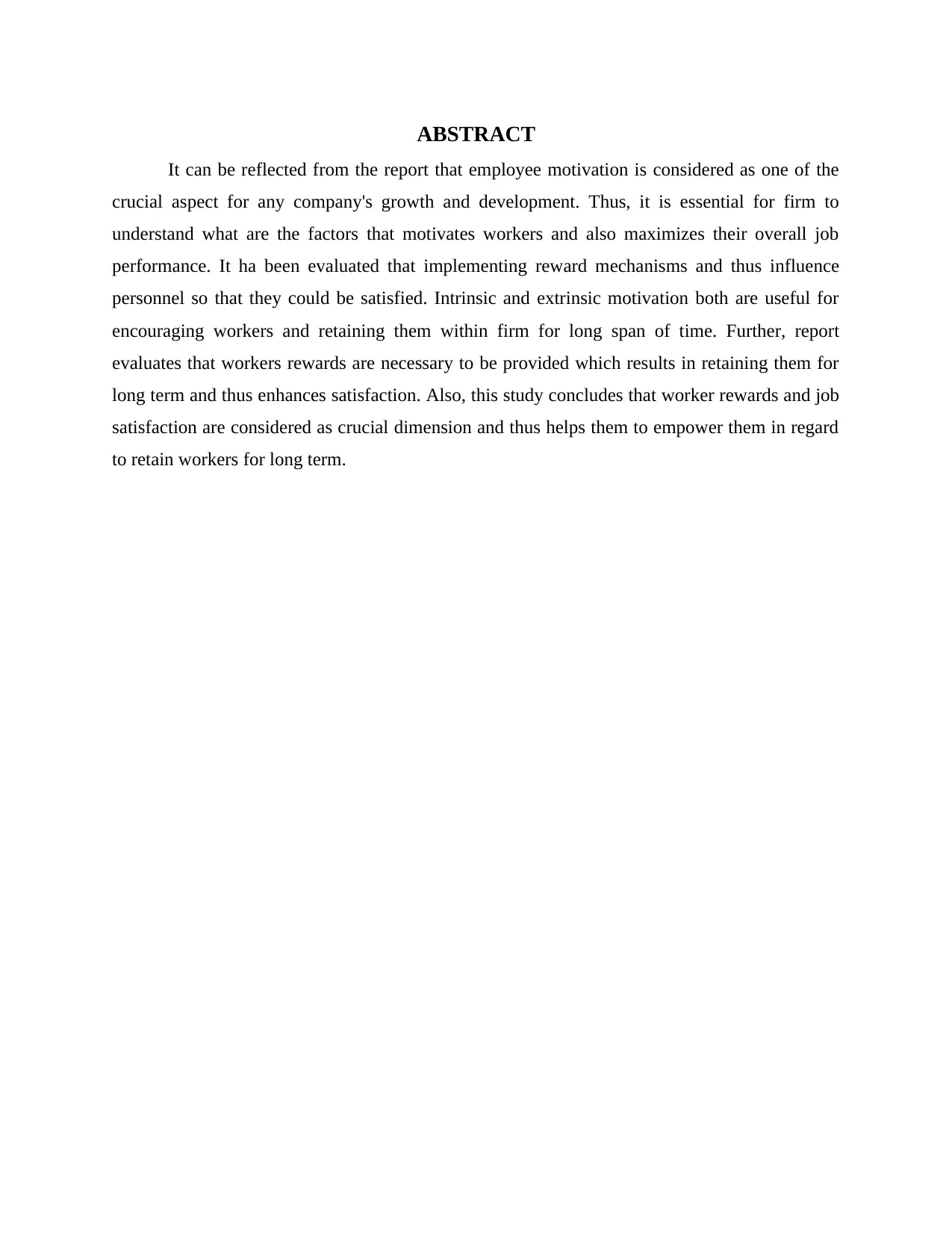
ABSTRACT
It can be reflected from the report that employee motivation is considered as one of the
crucial aspect for any company's growth and development. Thus, it is essential for firm to
understand what are the factors that motivates workers and also maximizes their overall job
performance. It ha been evaluated that implementing reward mechanisms and thus influence
personnel so that they could be satisfied. Intrinsic and extrinsic motivation both are useful for
encouraging workers and retaining them within firm for long span of time. Further, report
evaluates that workers rewards are necessary to be provided which results in retaining them for
long term and thus enhances satisfaction. Also, this study concludes that worker rewards and job
satisfaction are considered as crucial dimension and thus helps them to empower them in regard
to retain workers for long term.
It can be reflected from the report that employee motivation is considered as one of the
crucial aspect for any company's growth and development. Thus, it is essential for firm to
understand what are the factors that motivates workers and also maximizes their overall job
performance. It ha been evaluated that implementing reward mechanisms and thus influence
personnel so that they could be satisfied. Intrinsic and extrinsic motivation both are useful for
encouraging workers and retaining them within firm for long span of time. Further, report
evaluates that workers rewards are necessary to be provided which results in retaining them for
long term and thus enhances satisfaction. Also, this study concludes that worker rewards and job
satisfaction are considered as crucial dimension and thus helps them to empower them in regard
to retain workers for long term.
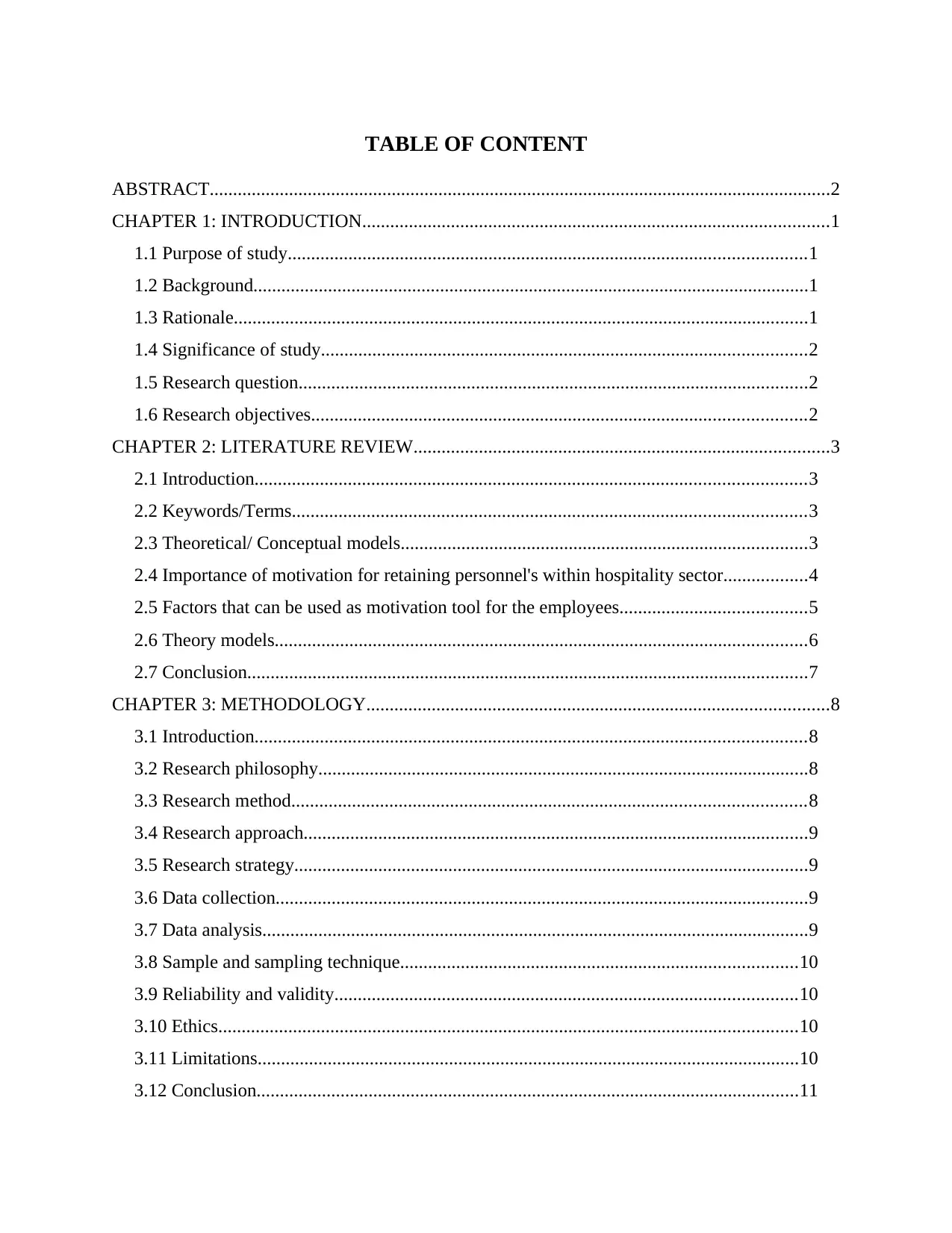
TABLE OF CONTENT
ABSTRACT.....................................................................................................................................2
CHAPTER 1: INTRODUCTION....................................................................................................1
1.1 Purpose of study...............................................................................................................1
1.2 Background.......................................................................................................................1
1.3 Rationale...........................................................................................................................1
1.4 Significance of study........................................................................................................2
1.5 Research question.............................................................................................................2
1.6 Research objectives..........................................................................................................2
CHAPTER 2: LITERATURE REVIEW.........................................................................................3
2.1 Introduction......................................................................................................................3
2.2 Keywords/Terms..............................................................................................................3
2.3 Theoretical/ Conceptual models.......................................................................................3
2.4 Importance of motivation for retaining personnel's within hospitality sector..................4
2.5 Factors that can be used as motivation tool for the employees........................................5
2.6 Theory models..................................................................................................................6
2.7 Conclusion........................................................................................................................7
CHAPTER 3: METHODOLOGY...................................................................................................8
3.1 Introduction......................................................................................................................8
3.2 Research philosophy.........................................................................................................8
3.3 Research method..............................................................................................................8
3.4 Research approach............................................................................................................9
3.5 Research strategy..............................................................................................................9
3.6 Data collection..................................................................................................................9
3.7 Data analysis.....................................................................................................................9
3.8 Sample and sampling technique.....................................................................................10
3.9 Reliability and validity...................................................................................................10
3.10 Ethics............................................................................................................................10
3.11 Limitations....................................................................................................................10
3.12 Conclusion....................................................................................................................11
ABSTRACT.....................................................................................................................................2
CHAPTER 1: INTRODUCTION....................................................................................................1
1.1 Purpose of study...............................................................................................................1
1.2 Background.......................................................................................................................1
1.3 Rationale...........................................................................................................................1
1.4 Significance of study........................................................................................................2
1.5 Research question.............................................................................................................2
1.6 Research objectives..........................................................................................................2
CHAPTER 2: LITERATURE REVIEW.........................................................................................3
2.1 Introduction......................................................................................................................3
2.2 Keywords/Terms..............................................................................................................3
2.3 Theoretical/ Conceptual models.......................................................................................3
2.4 Importance of motivation for retaining personnel's within hospitality sector..................4
2.5 Factors that can be used as motivation tool for the employees........................................5
2.6 Theory models..................................................................................................................6
2.7 Conclusion........................................................................................................................7
CHAPTER 3: METHODOLOGY...................................................................................................8
3.1 Introduction......................................................................................................................8
3.2 Research philosophy.........................................................................................................8
3.3 Research method..............................................................................................................8
3.4 Research approach............................................................................................................9
3.5 Research strategy..............................................................................................................9
3.6 Data collection..................................................................................................................9
3.7 Data analysis.....................................................................................................................9
3.8 Sample and sampling technique.....................................................................................10
3.9 Reliability and validity...................................................................................................10
3.10 Ethics............................................................................................................................10
3.11 Limitations....................................................................................................................10
3.12 Conclusion....................................................................................................................11
⊘ This is a preview!⊘
Do you want full access?
Subscribe today to unlock all pages.

Trusted by 1+ million students worldwide
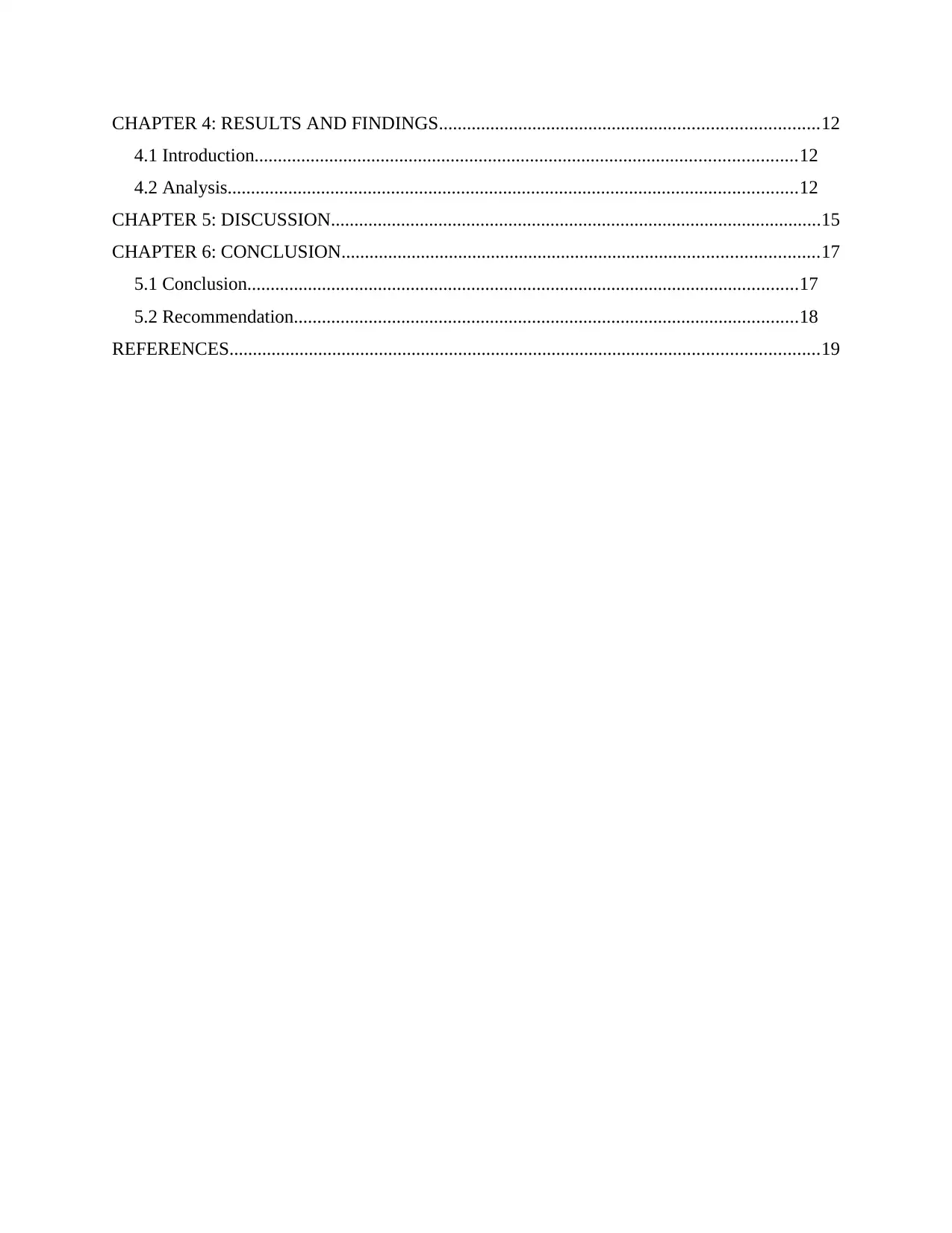
CHAPTER 4: RESULTS AND FINDINGS.................................................................................12
4.1 Introduction....................................................................................................................12
4.2 Analysis..........................................................................................................................12
CHAPTER 5: DISCUSSION.........................................................................................................15
CHAPTER 6: CONCLUSION......................................................................................................17
5.1 Conclusion......................................................................................................................17
5.2 Recommendation............................................................................................................18
REFERENCES..............................................................................................................................19
4.1 Introduction....................................................................................................................12
4.2 Analysis..........................................................................................................................12
CHAPTER 5: DISCUSSION.........................................................................................................15
CHAPTER 6: CONCLUSION......................................................................................................17
5.1 Conclusion......................................................................................................................17
5.2 Recommendation............................................................................................................18
REFERENCES..............................................................................................................................19
Paraphrase This Document
Need a fresh take? Get an instant paraphrase of this document with our AI Paraphraser
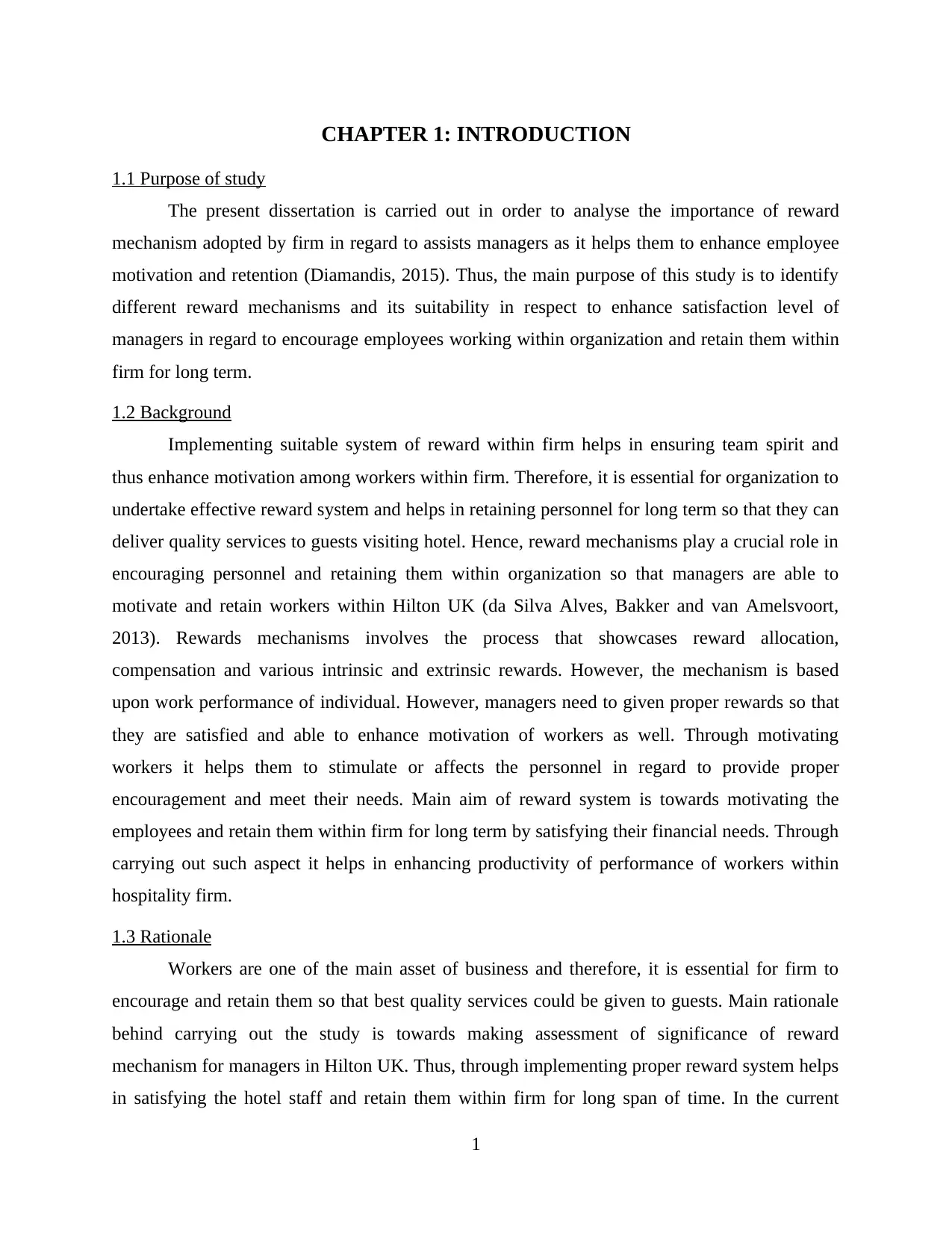
CHAPTER 1: INTRODUCTION
1.1 Purpose of study
The present dissertation is carried out in order to analyse the importance of reward
mechanism adopted by firm in regard to assists managers as it helps them to enhance employee
motivation and retention (Diamandis, 2015). Thus, the main purpose of this study is to identify
different reward mechanisms and its suitability in respect to enhance satisfaction level of
managers in regard to encourage employees working within organization and retain them within
firm for long term.
1.2 Background
Implementing suitable system of reward within firm helps in ensuring team spirit and
thus enhance motivation among workers within firm. Therefore, it is essential for organization to
undertake effective reward system and helps in retaining personnel for long term so that they can
deliver quality services to guests visiting hotel. Hence, reward mechanisms play a crucial role in
encouraging personnel and retaining them within organization so that managers are able to
motivate and retain workers within Hilton UK (da Silva Alves, Bakker and van Amelsvoort,
2013). Rewards mechanisms involves the process that showcases reward allocation,
compensation and various intrinsic and extrinsic rewards. However, the mechanism is based
upon work performance of individual. However, managers need to given proper rewards so that
they are satisfied and able to enhance motivation of workers as well. Through motivating
workers it helps them to stimulate or affects the personnel in regard to provide proper
encouragement and meet their needs. Main aim of reward system is towards motivating the
employees and retain them within firm for long term by satisfying their financial needs. Through
carrying out such aspect it helps in enhancing productivity of performance of workers within
hospitality firm.
1.3 Rationale
Workers are one of the main asset of business and therefore, it is essential for firm to
encourage and retain them so that best quality services could be given to guests. Main rationale
behind carrying out the study is towards making assessment of significance of reward
mechanism for managers in Hilton UK. Thus, through implementing proper reward system helps
in satisfying the hotel staff and retain them within firm for long span of time. In the current
1
1.1 Purpose of study
The present dissertation is carried out in order to analyse the importance of reward
mechanism adopted by firm in regard to assists managers as it helps them to enhance employee
motivation and retention (Diamandis, 2015). Thus, the main purpose of this study is to identify
different reward mechanisms and its suitability in respect to enhance satisfaction level of
managers in regard to encourage employees working within organization and retain them within
firm for long term.
1.2 Background
Implementing suitable system of reward within firm helps in ensuring team spirit and
thus enhance motivation among workers within firm. Therefore, it is essential for organization to
undertake effective reward system and helps in retaining personnel for long term so that they can
deliver quality services to guests visiting hotel. Hence, reward mechanisms play a crucial role in
encouraging personnel and retaining them within organization so that managers are able to
motivate and retain workers within Hilton UK (da Silva Alves, Bakker and van Amelsvoort,
2013). Rewards mechanisms involves the process that showcases reward allocation,
compensation and various intrinsic and extrinsic rewards. However, the mechanism is based
upon work performance of individual. However, managers need to given proper rewards so that
they are satisfied and able to enhance motivation of workers as well. Through motivating
workers it helps them to stimulate or affects the personnel in regard to provide proper
encouragement and meet their needs. Main aim of reward system is towards motivating the
employees and retain them within firm for long term by satisfying their financial needs. Through
carrying out such aspect it helps in enhancing productivity of performance of workers within
hospitality firm.
1.3 Rationale
Workers are one of the main asset of business and therefore, it is essential for firm to
encourage and retain them so that best quality services could be given to guests. Main rationale
behind carrying out the study is towards making assessment of significance of reward
mechanism for managers in Hilton UK. Thus, through implementing proper reward system helps
in satisfying the hotel staff and retain them within firm for long span of time. In the current
1
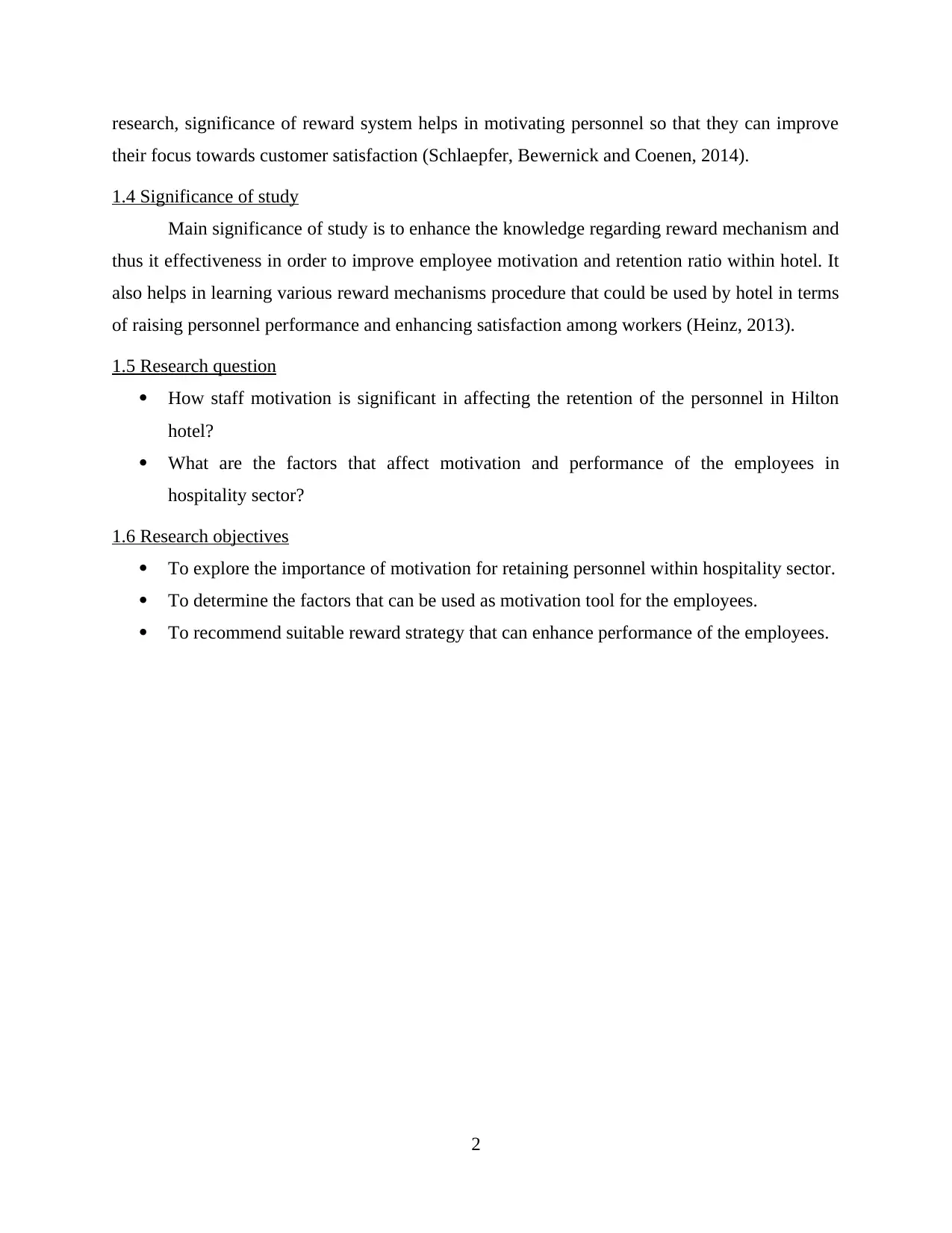
research, significance of reward system helps in motivating personnel so that they can improve
their focus towards customer satisfaction (Schlaepfer, Bewernick and Coenen, 2014).
1.4 Significance of study
Main significance of study is to enhance the knowledge regarding reward mechanism and
thus it effectiveness in order to improve employee motivation and retention ratio within hotel. It
also helps in learning various reward mechanisms procedure that could be used by hotel in terms
of raising personnel performance and enhancing satisfaction among workers (Heinz, 2013).
1.5 Research question
How staff motivation is significant in affecting the retention of the personnel in Hilton
hotel?
What are the factors that affect motivation and performance of the employees in
hospitality sector?
1.6 Research objectives
To explore the importance of motivation for retaining personnel within hospitality sector.
To determine the factors that can be used as motivation tool for the employees.
To recommend suitable reward strategy that can enhance performance of the employees.
2
their focus towards customer satisfaction (Schlaepfer, Bewernick and Coenen, 2014).
1.4 Significance of study
Main significance of study is to enhance the knowledge regarding reward mechanism and
thus it effectiveness in order to improve employee motivation and retention ratio within hotel. It
also helps in learning various reward mechanisms procedure that could be used by hotel in terms
of raising personnel performance and enhancing satisfaction among workers (Heinz, 2013).
1.5 Research question
How staff motivation is significant in affecting the retention of the personnel in Hilton
hotel?
What are the factors that affect motivation and performance of the employees in
hospitality sector?
1.6 Research objectives
To explore the importance of motivation for retaining personnel within hospitality sector.
To determine the factors that can be used as motivation tool for the employees.
To recommend suitable reward strategy that can enhance performance of the employees.
2
⊘ This is a preview!⊘
Do you want full access?
Subscribe today to unlock all pages.

Trusted by 1+ million students worldwide
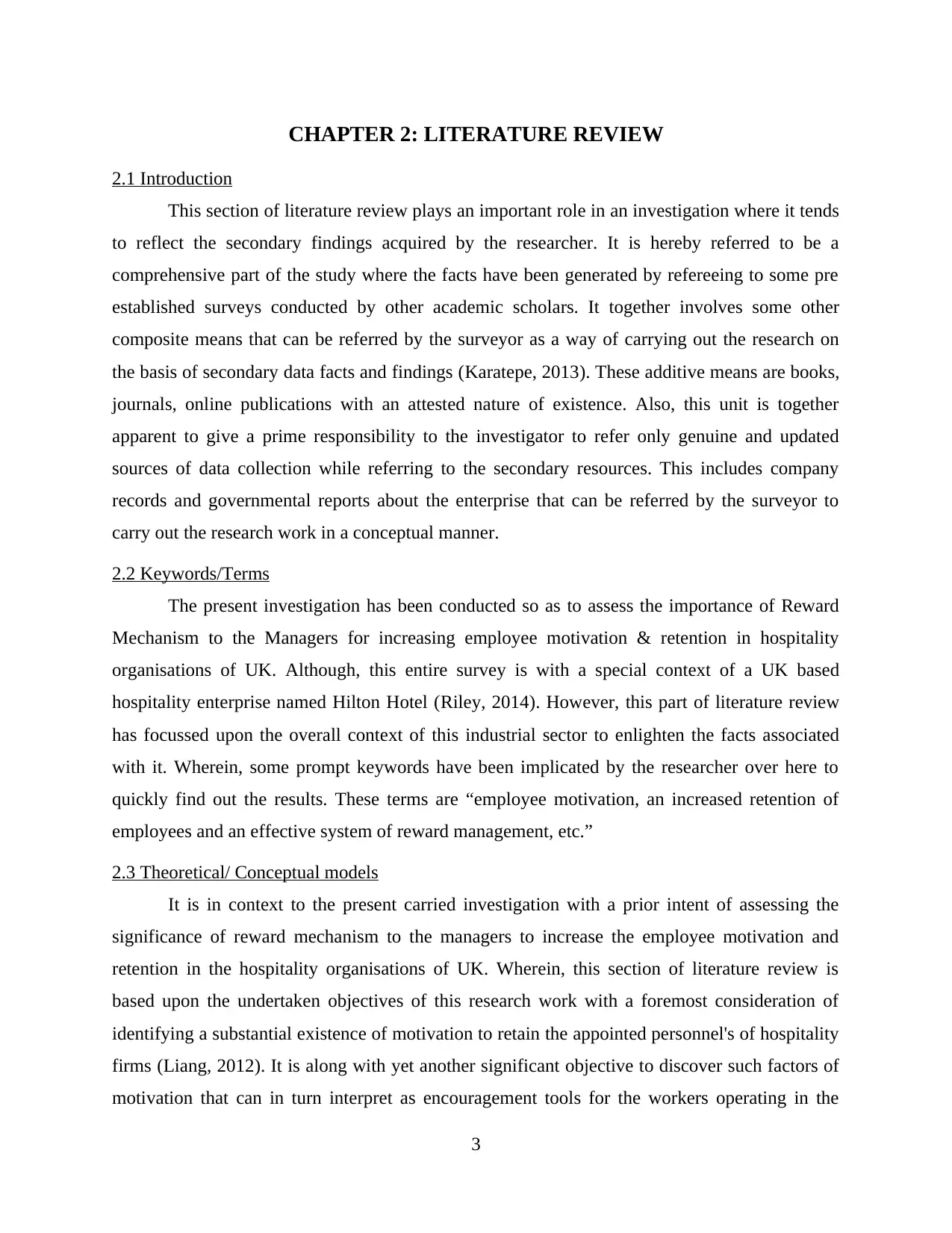
CHAPTER 2: LITERATURE REVIEW
2.1 Introduction
This section of literature review plays an important role in an investigation where it tends
to reflect the secondary findings acquired by the researcher. It is hereby referred to be a
comprehensive part of the study where the facts have been generated by refereeing to some pre
established surveys conducted by other academic scholars. It together involves some other
composite means that can be referred by the surveyor as a way of carrying out the research on
the basis of secondary data facts and findings (Karatepe, 2013). These additive means are books,
journals, online publications with an attested nature of existence. Also, this unit is together
apparent to give a prime responsibility to the investigator to refer only genuine and updated
sources of data collection while referring to the secondary resources. This includes company
records and governmental reports about the enterprise that can be referred by the surveyor to
carry out the research work in a conceptual manner.
2.2 Keywords/Terms
The present investigation has been conducted so as to assess the importance of Reward
Mechanism to the Managers for increasing employee motivation & retention in hospitality
organisations of UK. Although, this entire survey is with a special context of a UK based
hospitality enterprise named Hilton Hotel (Riley, 2014). However, this part of literature review
has focussed upon the overall context of this industrial sector to enlighten the facts associated
with it. Wherein, some prompt keywords have been implicated by the researcher over here to
quickly find out the results. These terms are “employee motivation, an increased retention of
employees and an effective system of reward management, etc.”
2.3 Theoretical/ Conceptual models
It is in context to the present carried investigation with a prior intent of assessing the
significance of reward mechanism to the managers to increase the employee motivation and
retention in the hospitality organisations of UK. Wherein, this section of literature review is
based upon the undertaken objectives of this research work with a foremost consideration of
identifying a substantial existence of motivation to retain the appointed personnel's of hospitality
firms (Liang, 2012). It is along with yet another significant objective to discover such factors of
motivation that can in turn interpret as encouragement tools for the workers operating in the
3
2.1 Introduction
This section of literature review plays an important role in an investigation where it tends
to reflect the secondary findings acquired by the researcher. It is hereby referred to be a
comprehensive part of the study where the facts have been generated by refereeing to some pre
established surveys conducted by other academic scholars. It together involves some other
composite means that can be referred by the surveyor as a way of carrying out the research on
the basis of secondary data facts and findings (Karatepe, 2013). These additive means are books,
journals, online publications with an attested nature of existence. Also, this unit is together
apparent to give a prime responsibility to the investigator to refer only genuine and updated
sources of data collection while referring to the secondary resources. This includes company
records and governmental reports about the enterprise that can be referred by the surveyor to
carry out the research work in a conceptual manner.
2.2 Keywords/Terms
The present investigation has been conducted so as to assess the importance of Reward
Mechanism to the Managers for increasing employee motivation & retention in hospitality
organisations of UK. Although, this entire survey is with a special context of a UK based
hospitality enterprise named Hilton Hotel (Riley, 2014). However, this part of literature review
has focussed upon the overall context of this industrial sector to enlighten the facts associated
with it. Wherein, some prompt keywords have been implicated by the researcher over here to
quickly find out the results. These terms are “employee motivation, an increased retention of
employees and an effective system of reward management, etc.”
2.3 Theoretical/ Conceptual models
It is in context to the present carried investigation with a prior intent of assessing the
significance of reward mechanism to the managers to increase the employee motivation and
retention in the hospitality organisations of UK. Wherein, this section of literature review is
based upon the undertaken objectives of this research work with a foremost consideration of
identifying a substantial existence of motivation to retain the appointed personnel's of hospitality
firms (Liang, 2012). It is along with yet another significant objective to discover such factors of
motivation that can in turn interpret as encouragement tools for the workers operating in the
3
Paraphrase This Document
Need a fresh take? Get an instant paraphrase of this document with our AI Paraphraser
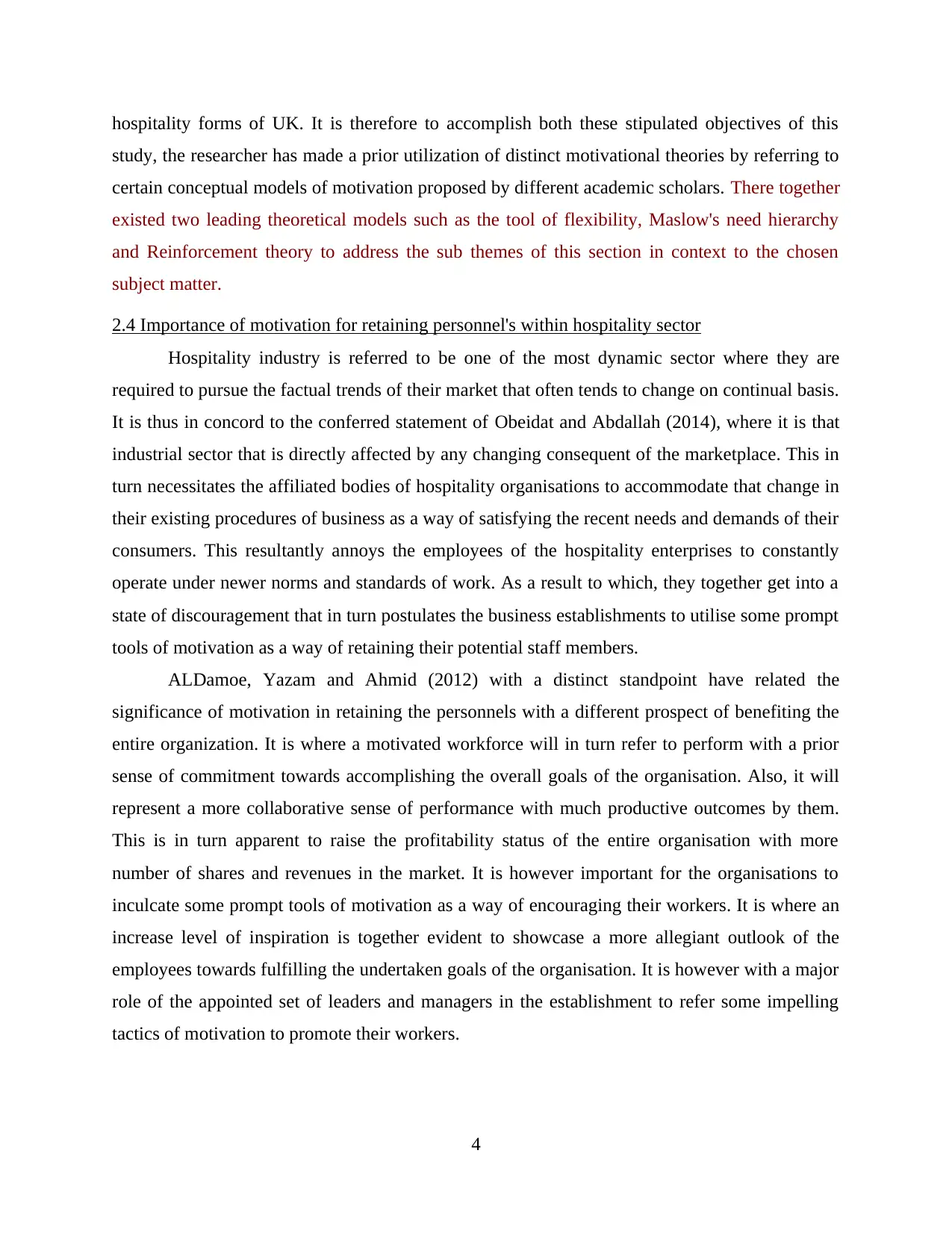
hospitality forms of UK. It is therefore to accomplish both these stipulated objectives of this
study, the researcher has made a prior utilization of distinct motivational theories by referring to
certain conceptual models of motivation proposed by different academic scholars. There together
existed two leading theoretical models such as the tool of flexibility, Maslow's need hierarchy
and Reinforcement theory to address the sub themes of this section in context to the chosen
subject matter.
2.4 Importance of motivation for retaining personnel's within hospitality sector
Hospitality industry is referred to be one of the most dynamic sector where they are
required to pursue the factual trends of their market that often tends to change on continual basis.
It is thus in concord to the conferred statement of Obeidat and Abdallah (2014), where it is that
industrial sector that is directly affected by any changing consequent of the marketplace. This in
turn necessitates the affiliated bodies of hospitality organisations to accommodate that change in
their existing procedures of business as a way of satisfying the recent needs and demands of their
consumers. This resultantly annoys the employees of the hospitality enterprises to constantly
operate under newer norms and standards of work. As a result to which, they together get into a
state of discouragement that in turn postulates the business establishments to utilise some prompt
tools of motivation as a way of retaining their potential staff members.
ALDamoe, Yazam and Ahmid (2012) with a distinct standpoint have related the
significance of motivation in retaining the personnels with a different prospect of benefiting the
entire organization. It is where a motivated workforce will in turn refer to perform with a prior
sense of commitment towards accomplishing the overall goals of the organisation. Also, it will
represent a more collaborative sense of performance with much productive outcomes by them.
This is in turn apparent to raise the profitability status of the entire organisation with more
number of shares and revenues in the market. It is however important for the organisations to
inculcate some prompt tools of motivation as a way of encouraging their workers. It is where an
increase level of inspiration is together evident to showcase a more allegiant outlook of the
employees towards fulfilling the undertaken goals of the organisation. It is however with a major
role of the appointed set of leaders and managers in the establishment to refer some impelling
tactics of motivation to promote their workers.
4
study, the researcher has made a prior utilization of distinct motivational theories by referring to
certain conceptual models of motivation proposed by different academic scholars. There together
existed two leading theoretical models such as the tool of flexibility, Maslow's need hierarchy
and Reinforcement theory to address the sub themes of this section in context to the chosen
subject matter.
2.4 Importance of motivation for retaining personnel's within hospitality sector
Hospitality industry is referred to be one of the most dynamic sector where they are
required to pursue the factual trends of their market that often tends to change on continual basis.
It is thus in concord to the conferred statement of Obeidat and Abdallah (2014), where it is that
industrial sector that is directly affected by any changing consequent of the marketplace. This in
turn necessitates the affiliated bodies of hospitality organisations to accommodate that change in
their existing procedures of business as a way of satisfying the recent needs and demands of their
consumers. This resultantly annoys the employees of the hospitality enterprises to constantly
operate under newer norms and standards of work. As a result to which, they together get into a
state of discouragement that in turn postulates the business establishments to utilise some prompt
tools of motivation as a way of retaining their potential staff members.
ALDamoe, Yazam and Ahmid (2012) with a distinct standpoint have related the
significance of motivation in retaining the personnels with a different prospect of benefiting the
entire organization. It is where a motivated workforce will in turn refer to perform with a prior
sense of commitment towards accomplishing the overall goals of the organisation. Also, it will
represent a more collaborative sense of performance with much productive outcomes by them.
This is in turn apparent to raise the profitability status of the entire organisation with more
number of shares and revenues in the market. It is however important for the organisations to
inculcate some prompt tools of motivation as a way of encouraging their workers. It is where an
increase level of inspiration is together evident to showcase a more allegiant outlook of the
employees towards fulfilling the undertaken goals of the organisation. It is however with a major
role of the appointed set of leaders and managers in the establishment to refer some impelling
tactics of motivation to promote their workers.
4
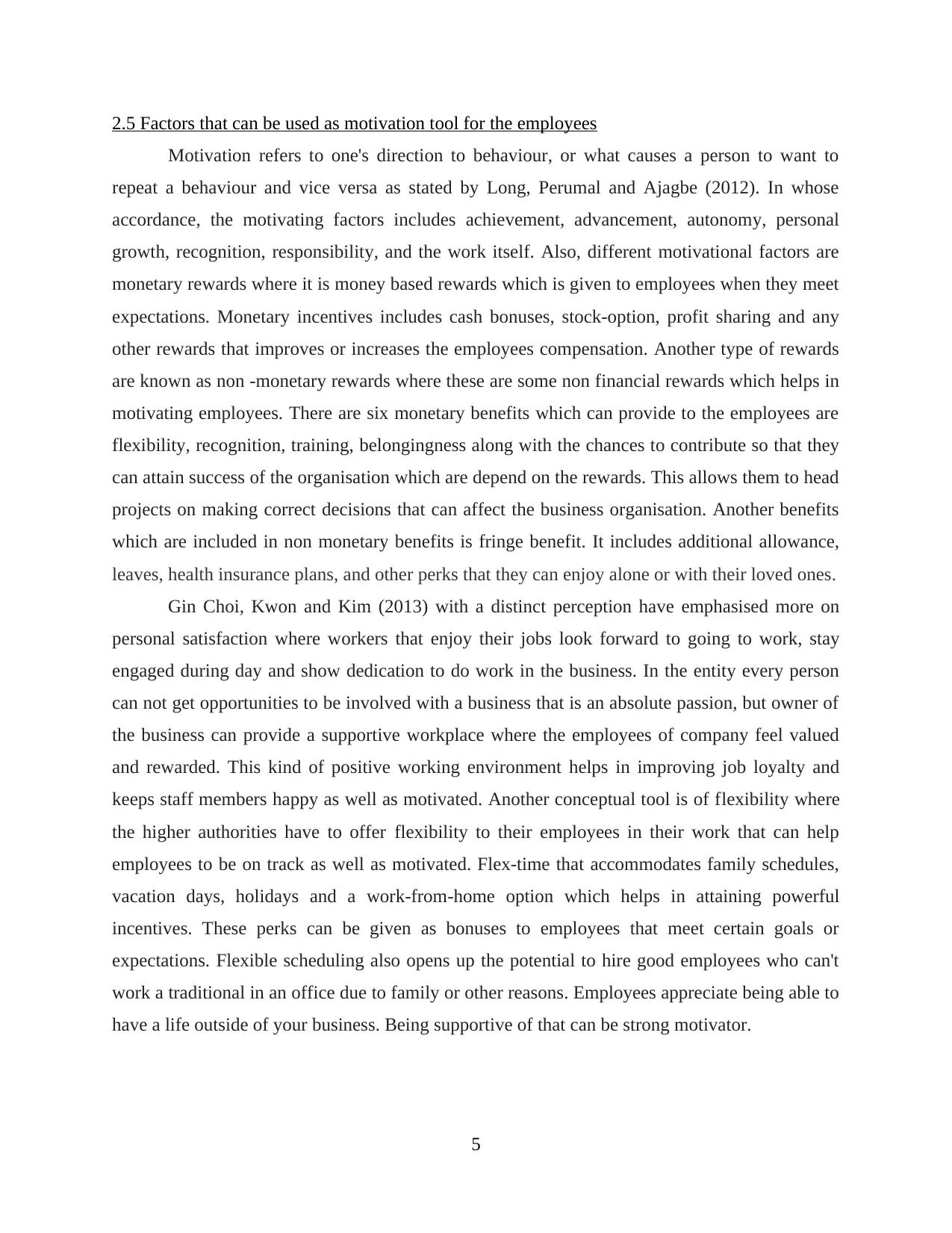
2.5 Factors that can be used as motivation tool for the employees
Motivation refers to one's direction to behaviour, or what causes a person to want to
repeat a behaviour and vice versa as stated by Long, Perumal and Ajagbe (2012). In whose
accordance, the motivating factors includes achievement, advancement, autonomy, personal
growth, recognition, responsibility, and the work itself. Also, different motivational factors are
monetary rewards where it is money based rewards which is given to employees when they meet
expectations. Monetary incentives includes cash bonuses, stock-option, profit sharing and any
other rewards that improves or increases the employees compensation. Another type of rewards
are known as non -monetary rewards where these are some non financial rewards which helps in
motivating employees. There are six monetary benefits which can provide to the employees are
flexibility, recognition, training, belongingness along with the chances to contribute so that they
can attain success of the organisation which are depend on the rewards. This allows them to head
projects on making correct decisions that can affect the business organisation. Another benefits
which are included in non monetary benefits is fringe benefit. It includes additional allowance,
leaves, health insurance plans, and other perks that they can enjoy alone or with their loved ones.
Gin Choi, Kwon and Kim (2013) with a distinct perception have emphasised more on
personal satisfaction where workers that enjoy their jobs look forward to going to work, stay
engaged during day and show dedication to do work in the business. In the entity every person
can not get opportunities to be involved with a business that is an absolute passion, but owner of
the business can provide a supportive workplace where the employees of company feel valued
and rewarded. This kind of positive working environment helps in improving job loyalty and
keeps staff members happy as well as motivated. Another conceptual tool is of flexibility where
the higher authorities have to offer flexibility to their employees in their work that can help
employees to be on track as well as motivated. Flex-time that accommodates family schedules,
vacation days, holidays and a work-from-home option which helps in attaining powerful
incentives. These perks can be given as bonuses to employees that meet certain goals or
expectations. Flexible scheduling also opens up the potential to hire good employees who can't
work a traditional in an office due to family or other reasons. Employees appreciate being able to
have a life outside of your business. Being supportive of that can be strong motivator.
5
Motivation refers to one's direction to behaviour, or what causes a person to want to
repeat a behaviour and vice versa as stated by Long, Perumal and Ajagbe (2012). In whose
accordance, the motivating factors includes achievement, advancement, autonomy, personal
growth, recognition, responsibility, and the work itself. Also, different motivational factors are
monetary rewards where it is money based rewards which is given to employees when they meet
expectations. Monetary incentives includes cash bonuses, stock-option, profit sharing and any
other rewards that improves or increases the employees compensation. Another type of rewards
are known as non -monetary rewards where these are some non financial rewards which helps in
motivating employees. There are six monetary benefits which can provide to the employees are
flexibility, recognition, training, belongingness along with the chances to contribute so that they
can attain success of the organisation which are depend on the rewards. This allows them to head
projects on making correct decisions that can affect the business organisation. Another benefits
which are included in non monetary benefits is fringe benefit. It includes additional allowance,
leaves, health insurance plans, and other perks that they can enjoy alone or with their loved ones.
Gin Choi, Kwon and Kim (2013) with a distinct perception have emphasised more on
personal satisfaction where workers that enjoy their jobs look forward to going to work, stay
engaged during day and show dedication to do work in the business. In the entity every person
can not get opportunities to be involved with a business that is an absolute passion, but owner of
the business can provide a supportive workplace where the employees of company feel valued
and rewarded. This kind of positive working environment helps in improving job loyalty and
keeps staff members happy as well as motivated. Another conceptual tool is of flexibility where
the higher authorities have to offer flexibility to their employees in their work that can help
employees to be on track as well as motivated. Flex-time that accommodates family schedules,
vacation days, holidays and a work-from-home option which helps in attaining powerful
incentives. These perks can be given as bonuses to employees that meet certain goals or
expectations. Flexible scheduling also opens up the potential to hire good employees who can't
work a traditional in an office due to family or other reasons. Employees appreciate being able to
have a life outside of your business. Being supportive of that can be strong motivator.
5
⊘ This is a preview!⊘
Do you want full access?
Subscribe today to unlock all pages.

Trusted by 1+ million students worldwide
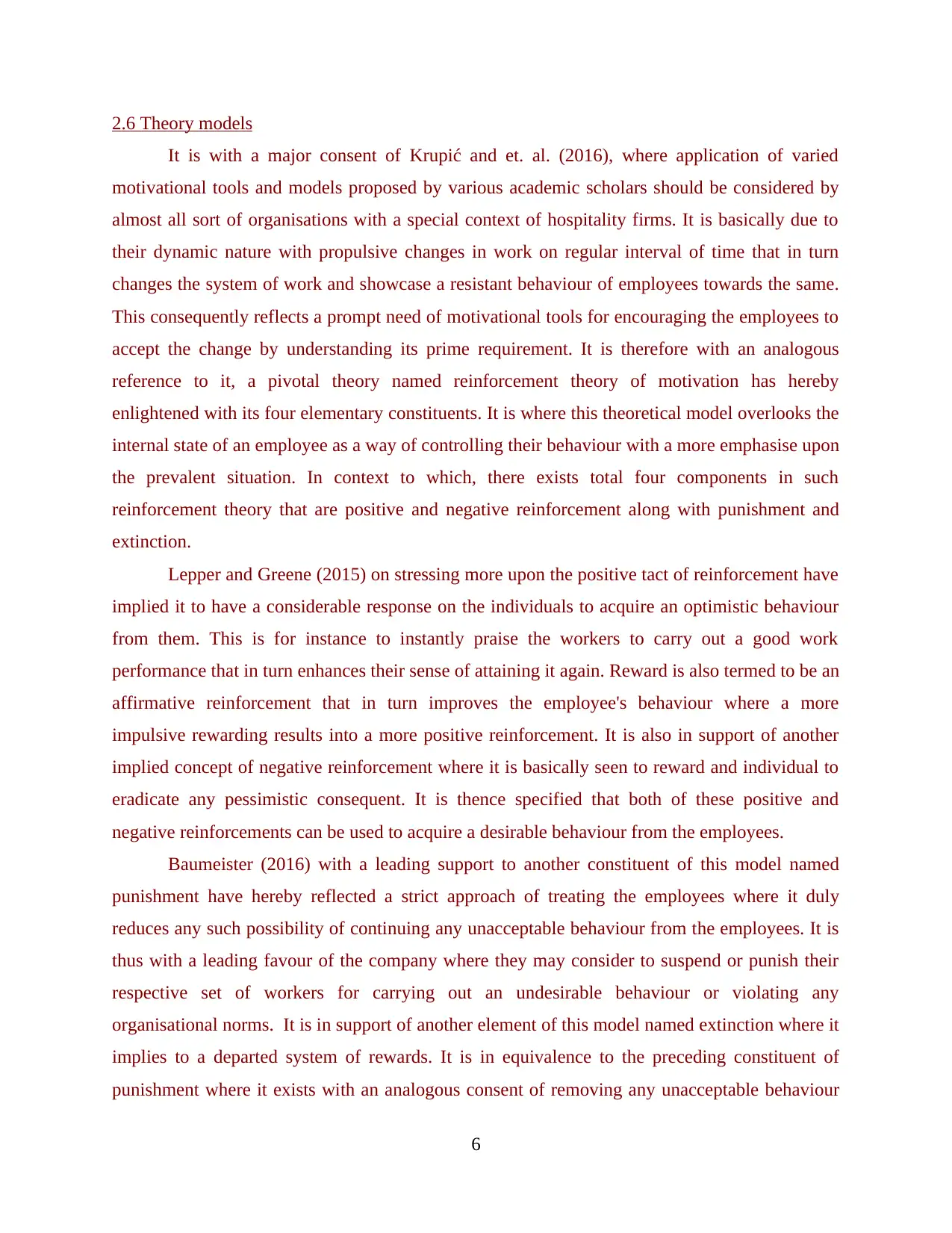
2.6 Theory models
It is with a major consent of Krupić and et. al. (2016), where application of varied
motivational tools and models proposed by various academic scholars should be considered by
almost all sort of organisations with a special context of hospitality firms. It is basically due to
their dynamic nature with propulsive changes in work on regular interval of time that in turn
changes the system of work and showcase a resistant behaviour of employees towards the same.
This consequently reflects a prompt need of motivational tools for encouraging the employees to
accept the change by understanding its prime requirement. It is therefore with an analogous
reference to it, a pivotal theory named reinforcement theory of motivation has hereby
enlightened with its four elementary constituents. It is where this theoretical model overlooks the
internal state of an employee as a way of controlling their behaviour with a more emphasise upon
the prevalent situation. In context to which, there exists total four components in such
reinforcement theory that are positive and negative reinforcement along with punishment and
extinction.
Lepper and Greene (2015) on stressing more upon the positive tact of reinforcement have
implied it to have a considerable response on the individuals to acquire an optimistic behaviour
from them. This is for instance to instantly praise the workers to carry out a good work
performance that in turn enhances their sense of attaining it again. Reward is also termed to be an
affirmative reinforcement that in turn improves the employee's behaviour where a more
impulsive rewarding results into a more positive reinforcement. It is also in support of another
implied concept of negative reinforcement where it is basically seen to reward and individual to
eradicate any pessimistic consequent. It is thence specified that both of these positive and
negative reinforcements can be used to acquire a desirable behaviour from the employees.
Baumeister (2016) with a leading support to another constituent of this model named
punishment have hereby reflected a strict approach of treating the employees where it duly
reduces any such possibility of continuing any unacceptable behaviour from the employees. It is
thus with a leading favour of the company where they may consider to suspend or punish their
respective set of workers for carrying out an undesirable behaviour or violating any
organisational norms. It is in support of another element of this model named extinction where it
implies to a departed system of rewards. It is in equivalence to the preceding constituent of
punishment where it exists with an analogous consent of removing any unacceptable behaviour
6
It is with a major consent of Krupić and et. al. (2016), where application of varied
motivational tools and models proposed by various academic scholars should be considered by
almost all sort of organisations with a special context of hospitality firms. It is basically due to
their dynamic nature with propulsive changes in work on regular interval of time that in turn
changes the system of work and showcase a resistant behaviour of employees towards the same.
This consequently reflects a prompt need of motivational tools for encouraging the employees to
accept the change by understanding its prime requirement. It is therefore with an analogous
reference to it, a pivotal theory named reinforcement theory of motivation has hereby
enlightened with its four elementary constituents. It is where this theoretical model overlooks the
internal state of an employee as a way of controlling their behaviour with a more emphasise upon
the prevalent situation. In context to which, there exists total four components in such
reinforcement theory that are positive and negative reinforcement along with punishment and
extinction.
Lepper and Greene (2015) on stressing more upon the positive tact of reinforcement have
implied it to have a considerable response on the individuals to acquire an optimistic behaviour
from them. This is for instance to instantly praise the workers to carry out a good work
performance that in turn enhances their sense of attaining it again. Reward is also termed to be an
affirmative reinforcement that in turn improves the employee's behaviour where a more
impulsive rewarding results into a more positive reinforcement. It is also in support of another
implied concept of negative reinforcement where it is basically seen to reward and individual to
eradicate any pessimistic consequent. It is thence specified that both of these positive and
negative reinforcements can be used to acquire a desirable behaviour from the employees.
Baumeister (2016) with a leading support to another constituent of this model named
punishment have hereby reflected a strict approach of treating the employees where it duly
reduces any such possibility of continuing any unacceptable behaviour from the employees. It is
thus with a leading favour of the company where they may consider to suspend or punish their
respective set of workers for carrying out an undesirable behaviour or violating any
organisational norms. It is in support of another element of this model named extinction where it
implies to a departed system of rewards. It is in equivalence to the preceding constituent of
punishment where it exists with an analogous consent of removing any unacceptable behaviour
6
Paraphrase This Document
Need a fresh take? Get an instant paraphrase of this document with our AI Paraphraser
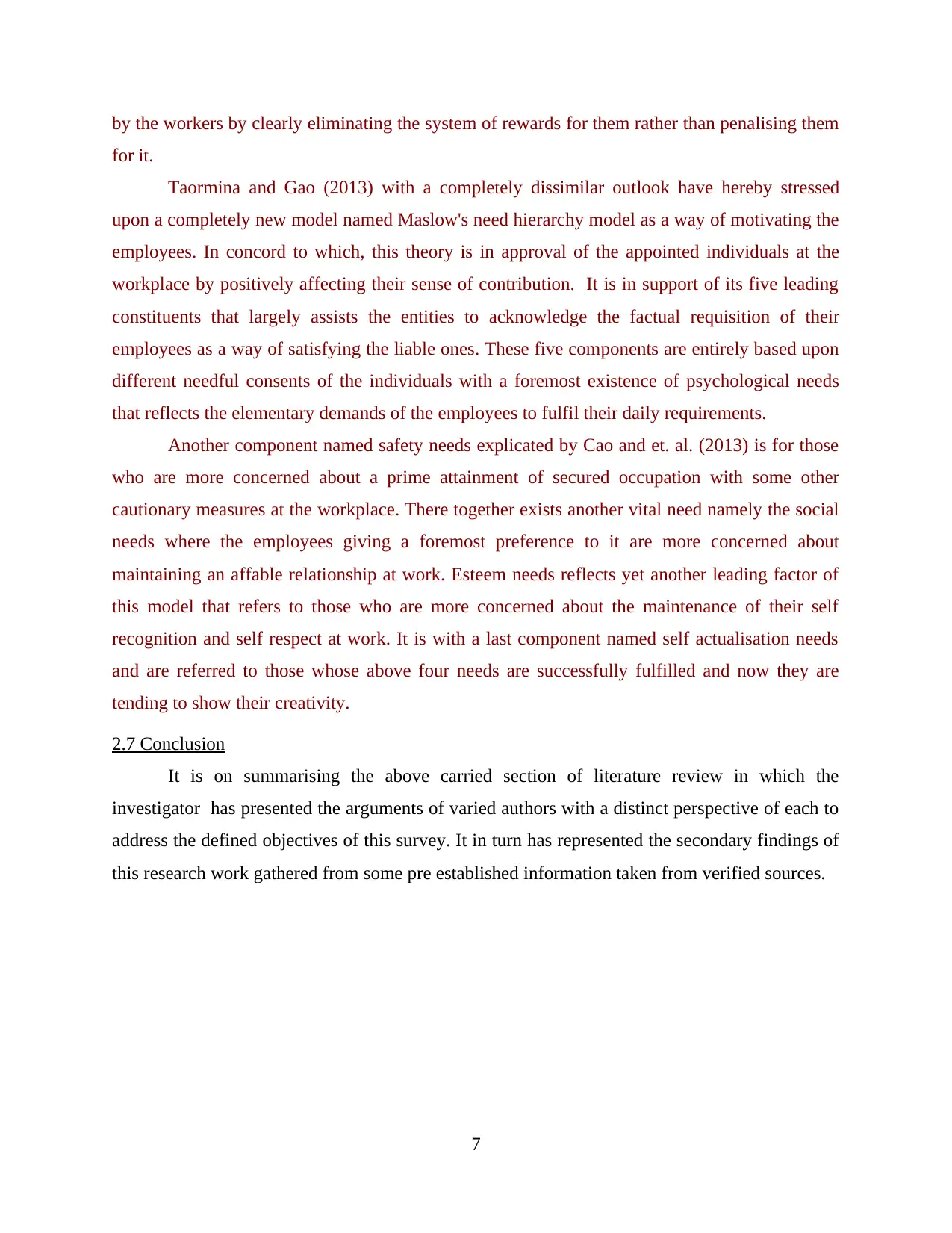
by the workers by clearly eliminating the system of rewards for them rather than penalising them
for it.
Taormina and Gao (2013) with a completely dissimilar outlook have hereby stressed
upon a completely new model named Maslow's need hierarchy model as a way of motivating the
employees. In concord to which, this theory is in approval of the appointed individuals at the
workplace by positively affecting their sense of contribution. It is in support of its five leading
constituents that largely assists the entities to acknowledge the factual requisition of their
employees as a way of satisfying the liable ones. These five components are entirely based upon
different needful consents of the individuals with a foremost existence of psychological needs
that reflects the elementary demands of the employees to fulfil their daily requirements.
Another component named safety needs explicated by Cao and et. al. (2013) is for those
who are more concerned about a prime attainment of secured occupation with some other
cautionary measures at the workplace. There together exists another vital need namely the social
needs where the employees giving a foremost preference to it are more concerned about
maintaining an affable relationship at work. Esteem needs reflects yet another leading factor of
this model that refers to those who are more concerned about the maintenance of their self
recognition and self respect at work. It is with a last component named self actualisation needs
and are referred to those whose above four needs are successfully fulfilled and now they are
tending to show their creativity.
2.7 Conclusion
It is on summarising the above carried section of literature review in which the
investigator has presented the arguments of varied authors with a distinct perspective of each to
address the defined objectives of this survey. It in turn has represented the secondary findings of
this research work gathered from some pre established information taken from verified sources.
7
for it.
Taormina and Gao (2013) with a completely dissimilar outlook have hereby stressed
upon a completely new model named Maslow's need hierarchy model as a way of motivating the
employees. In concord to which, this theory is in approval of the appointed individuals at the
workplace by positively affecting their sense of contribution. It is in support of its five leading
constituents that largely assists the entities to acknowledge the factual requisition of their
employees as a way of satisfying the liable ones. These five components are entirely based upon
different needful consents of the individuals with a foremost existence of psychological needs
that reflects the elementary demands of the employees to fulfil their daily requirements.
Another component named safety needs explicated by Cao and et. al. (2013) is for those
who are more concerned about a prime attainment of secured occupation with some other
cautionary measures at the workplace. There together exists another vital need namely the social
needs where the employees giving a foremost preference to it are more concerned about
maintaining an affable relationship at work. Esteem needs reflects yet another leading factor of
this model that refers to those who are more concerned about the maintenance of their self
recognition and self respect at work. It is with a last component named self actualisation needs
and are referred to those whose above four needs are successfully fulfilled and now they are
tending to show their creativity.
2.7 Conclusion
It is on summarising the above carried section of literature review in which the
investigator has presented the arguments of varied authors with a distinct perspective of each to
address the defined objectives of this survey. It in turn has represented the secondary findings of
this research work gathered from some pre established information taken from verified sources.
7
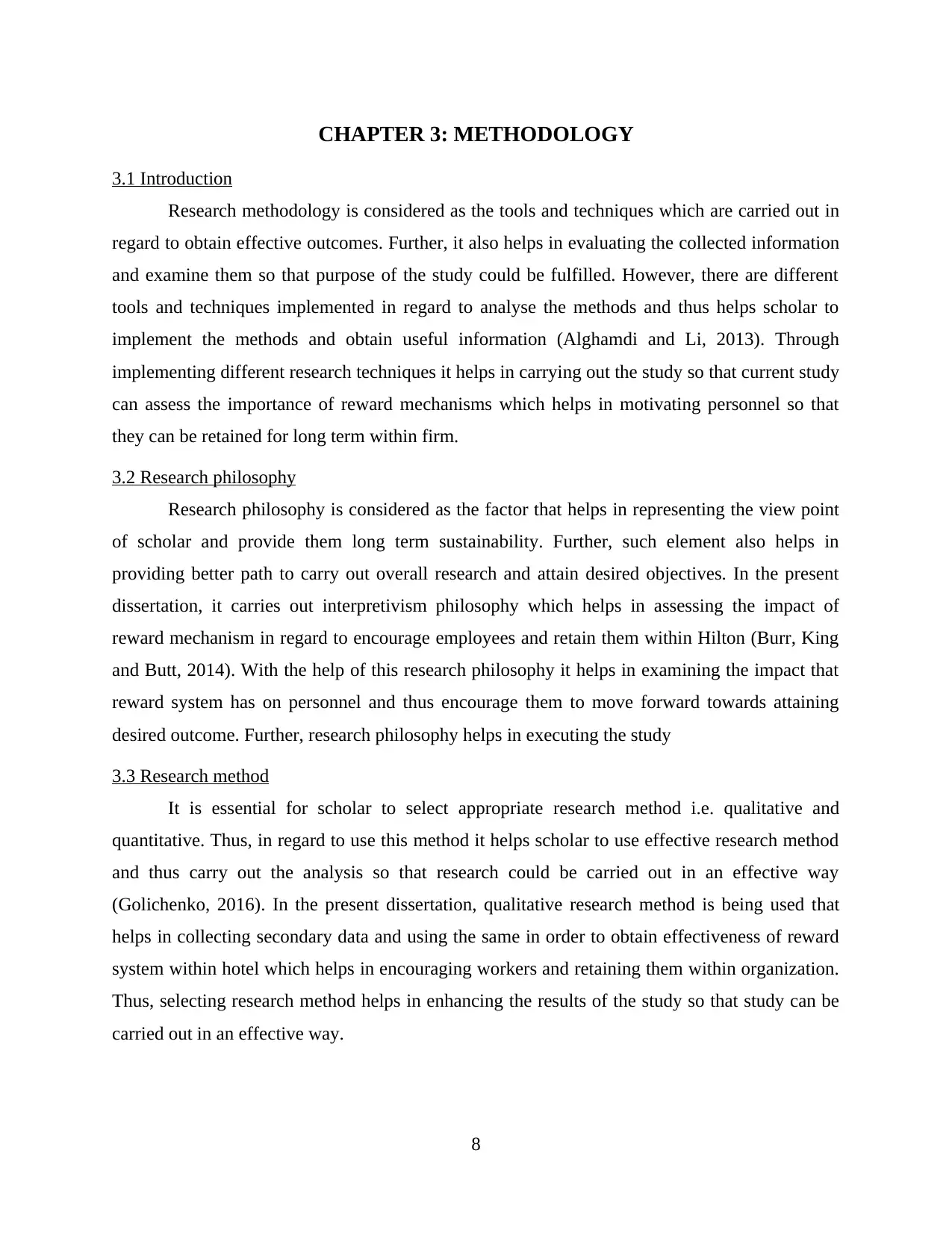
CHAPTER 3: METHODOLOGY
3.1 Introduction
Research methodology is considered as the tools and techniques which are carried out in
regard to obtain effective outcomes. Further, it also helps in evaluating the collected information
and examine them so that purpose of the study could be fulfilled. However, there are different
tools and techniques implemented in regard to analyse the methods and thus helps scholar to
implement the methods and obtain useful information (Alghamdi and Li, 2013). Through
implementing different research techniques it helps in carrying out the study so that current study
can assess the importance of reward mechanisms which helps in motivating personnel so that
they can be retained for long term within firm.
3.2 Research philosophy
Research philosophy is considered as the factor that helps in representing the view point
of scholar and provide them long term sustainability. Further, such element also helps in
providing better path to carry out overall research and attain desired objectives. In the present
dissertation, it carries out interpretivism philosophy which helps in assessing the impact of
reward mechanism in regard to encourage employees and retain them within Hilton (Burr, King
and Butt, 2014). With the help of this research philosophy it helps in examining the impact that
reward system has on personnel and thus encourage them to move forward towards attaining
desired outcome. Further, research philosophy helps in executing the study
3.3 Research method
It is essential for scholar to select appropriate research method i.e. qualitative and
quantitative. Thus, in regard to use this method it helps scholar to use effective research method
and thus carry out the analysis so that research could be carried out in an effective way
(Golichenko, 2016). In the present dissertation, qualitative research method is being used that
helps in collecting secondary data and using the same in order to obtain effectiveness of reward
system within hotel which helps in encouraging workers and retaining them within organization.
Thus, selecting research method helps in enhancing the results of the study so that study can be
carried out in an effective way.
8
3.1 Introduction
Research methodology is considered as the tools and techniques which are carried out in
regard to obtain effective outcomes. Further, it also helps in evaluating the collected information
and examine them so that purpose of the study could be fulfilled. However, there are different
tools and techniques implemented in regard to analyse the methods and thus helps scholar to
implement the methods and obtain useful information (Alghamdi and Li, 2013). Through
implementing different research techniques it helps in carrying out the study so that current study
can assess the importance of reward mechanisms which helps in motivating personnel so that
they can be retained for long term within firm.
3.2 Research philosophy
Research philosophy is considered as the factor that helps in representing the view point
of scholar and provide them long term sustainability. Further, such element also helps in
providing better path to carry out overall research and attain desired objectives. In the present
dissertation, it carries out interpretivism philosophy which helps in assessing the impact of
reward mechanism in regard to encourage employees and retain them within Hilton (Burr, King
and Butt, 2014). With the help of this research philosophy it helps in examining the impact that
reward system has on personnel and thus encourage them to move forward towards attaining
desired outcome. Further, research philosophy helps in executing the study
3.3 Research method
It is essential for scholar to select appropriate research method i.e. qualitative and
quantitative. Thus, in regard to use this method it helps scholar to use effective research method
and thus carry out the analysis so that research could be carried out in an effective way
(Golichenko, 2016). In the present dissertation, qualitative research method is being used that
helps in collecting secondary data and using the same in order to obtain effectiveness of reward
system within hotel which helps in encouraging workers and retaining them within organization.
Thus, selecting research method helps in enhancing the results of the study so that study can be
carried out in an effective way.
8
⊘ This is a preview!⊘
Do you want full access?
Subscribe today to unlock all pages.

Trusted by 1+ million students worldwide
1 out of 25
Related Documents
Your All-in-One AI-Powered Toolkit for Academic Success.
+13062052269
info@desklib.com
Available 24*7 on WhatsApp / Email
![[object Object]](/_next/static/media/star-bottom.7253800d.svg)
Unlock your academic potential
Copyright © 2020–2025 A2Z Services. All Rights Reserved. Developed and managed by ZUCOL.





